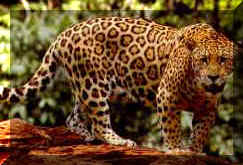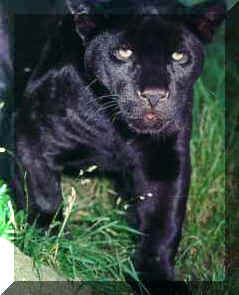


Jaguar
STATUS: Endangered.
DESCRIPTION: Compact body with broad head and powerful
paws. Coat is a yellowish-brown with a pale chest and black spots. Lower part of tail is
ringed with black, and ears have black edges.
SIZE: 5 to 6 feet in length from head to tip of tail.
Weighs 140-220 pounds (females slightly smaller).
HABITAT: Prefers thick forest or swamps with good cover
and water access, although known to hunt in arid open areas when necessary.
RANGE: Jaguars once ranged from Southwestern and
Southeastern United States -- in 1950 some were still found in Arizona -- to Central and
South America. Today it is thought to be extinct in the United States and very rare in
Mexico, Central America, and eastern Brazil. Jaguars can still be found in Patagonia.
FOOD SOURCE: Peccaries (wild pigs) and capybaras are
the most important foods to the jaguar, but will feed upon deer, sloth, cayman, tapir,
fresh water fish, and smaller animals. Occasionally prey on domestic livestock.
BEHAVIOR: South American name "jaguara" is
said to mean "carnivore that overcomes prey with a single bound." Jaguars stalk
and ambush their kill, often dragging the carcass to a safe spot some distance away before
eating it. They swim and climb very well. Jaguars do not roar, but they do snarl and
growl. They are solitary animals and some males have been known to wander for miles (as
many as 500 miles) for no known reason. Jaguars den in caves and canyons, and need to be
fairly close to a source of fresh water.
REPRODUCTION: Gestation period is around 100-110 days.
One to three young are born. Their eyes open after 13 days and they remain with the mother
for two years.
LONGEVITY: Up to 22 years in captivity.
SURVIVAL THREATS: Fur trade, habitat loss and hunting
by ranchers.
LEGAL PROTECTION: CITES, Appendix I, Endangered Species
Act
